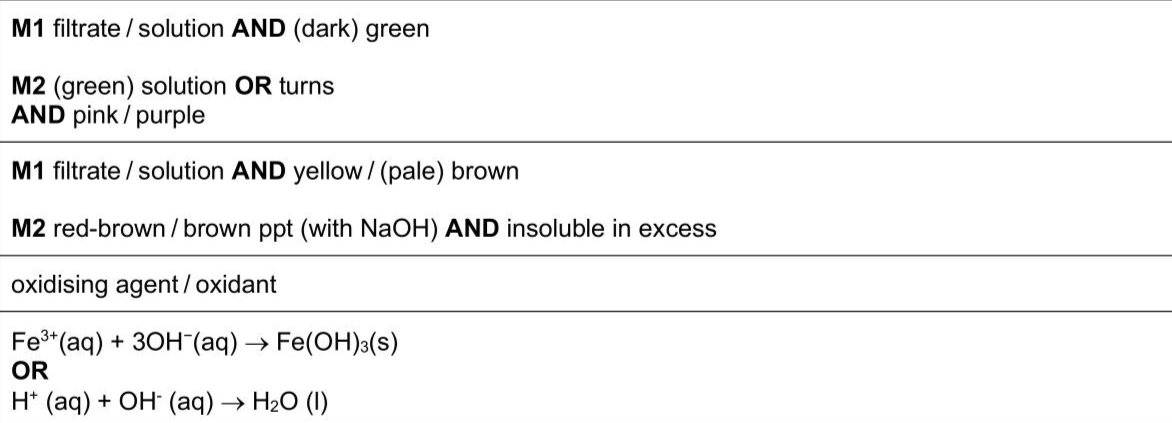Transfer a 2 cm depth of FA 2, $$\(\mathrm{KMnO}_{4}\)$$, into a test-tube. Add the same volume of aqueous sodium hydroxide followed by a small spatula measure of $$\(\mathbf{F A 5}, \mathrm{MnO}_{2}\)$$. Stir for approximately 30 seconds then filter the mixture into a second test-tube. observations . Add dilute sulfuric acid to the filtrate until no further change. observations . (ii) Transfer a 1 cm depth of aqueous iron(II) sulfate into a boiling tube. Add the same depth of dilute sulfuric acid followed by a very small spatula measure of $$\(\mathbf{F A 5}, \mathrm{MnO}_{2}\)$$. Carefully warm the mixture using a Bunsen burner for about 20 seconds. Filter the warm mixture into a test-tube. observations . Add aqueous sodium hydroxide dropwise to the filtrate until no further change. observations . (iii) Suggest a conclusion about the chemical behaviour of FA 5 using your observations in (a)(ii). FA 5 is acting as ...................................................................................................... (iv) Write an ionic equation for the reaction between aqueous sodium hydroxide and the filtrate in (a)(ii). Include state symbols. .................................................................................................................................
Exam No:9701_s25_qp_37 Year:2025 Question No:3(a)
Answer:

Knowledge points:
11.3.1 describe the relative reactivity of halide ions as reducing agents
11.3.2.1 aqueous silver ions followed by aqueous ammonia (the formation and formula of the $\left[\mathrm{Ag}\left(\mathrm{NH}_{3}\right)_{2}\right]^{+}$ complex is not required)
11.3.2.2 concentrated sulfuric acid, to include balanced chemical equations
3.2.1 define ionic bonding as the electrostatic attraction between oppositely charged ions (positively charged cations and negatively charged anions) describe ionic bonding including the examples of sodium chloride, magnesium oxide and calcium fluoride
6.1.1 calculate oxidation numbers of elements in compounds and ions
6.1.2 use changes in oxidation numbers to help balance chemical equations
6.1.3 explain and use the terms redox, oxidation, reduction and disproportionation in terms of electron transfer and changes in oxidation number
6.1.4 explain and use the terms oxidising agent and reducing agent
6.1.5 use a Roman numeral to indicate the magnitude of the oxidation number of an element
7.2.1 state the names and formulae of the common acids, limited to hydrochloric acid, HC/, sulfuric acid, ethanoic acid,
7.2.10 select suitable indicators for acid-alkali titrations, given appropriate data
7.2.2 state the names and formulae of the common alkalis, limited to sodium hydroxide, NaOH, potassium hydroxide, KOH, ammonia,
7.2.3 describe the Brønsted–Lowry theory of acids and bases
7.2.4 describe strong acids and strong bases as fully dissociated in aqueous solution and weak acids and weak bases as partially dissociated in aqueous solution
7.2.5 appreciate that water has pH of 7, acid solutions pH of below 7 and alkaline solutions pH of above 7
7.2.6 explain qualitatively the differences in behaviour between strong and weak acids including the reaction with a reactive metal and difference in pH values by use of a pH meter, universal indicator or conductivity
7.2.7 understand that neutralisation reactions occur when
7.2.8 understand that salts are formed in neutralisation reactions
7.2.9 sketch the pH titration curves of titrations using combinations of strong and weak acids with strong and weak alkalis
8.3.1.1 explain that, in the presence of a catalyst, a reaction has a different mechanism, i.e. one of lower activation energy
8.3.1.2 explain this catalytic effect in terms of the Boltzmann distribution
8.3.1.3 construct and interpret a reaction pathway diagram, for a reaction in the presence and absence of an effective catalyst
Solution:
Download APP for more features
1. Tons of answers.
2. Smarter Al tools enhance your learning journey.
IOS
Download
Download
Android
Download
Download
Google Play
Download
Download
